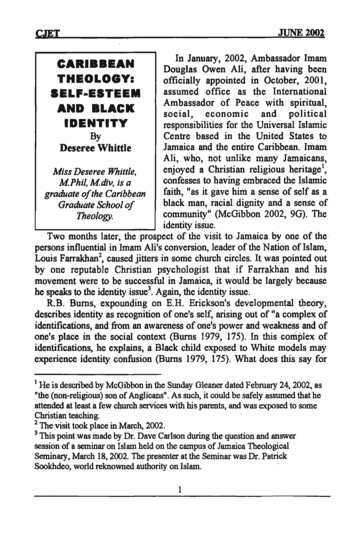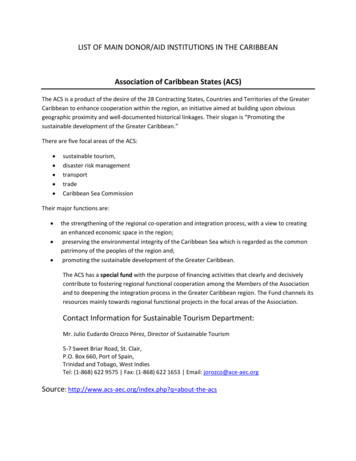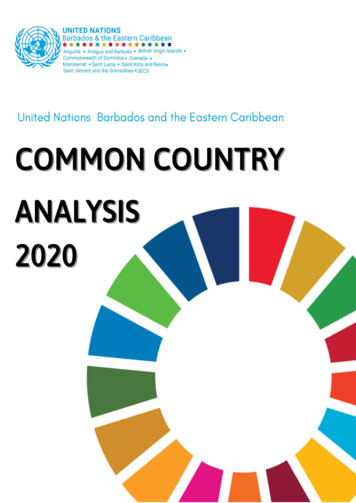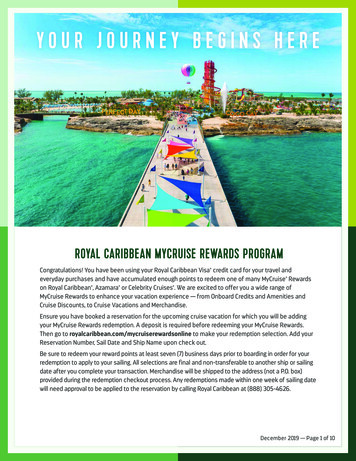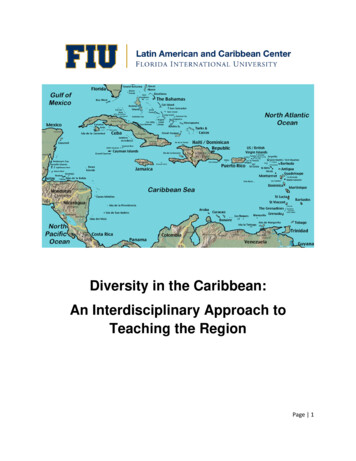
Transcription
Diversity in the Caribbean:An Interdisciplinary Approach toTeaching the RegionPage 1
Table of ContentsPages 3-5Introduction to Diversity in the Caribbean: An InterdisciplinaryApproach to Teaching the RegionPages 6-13Lesson 1: Earthquakes, Hurricanes and Tsunamis in the CaribbeanPages 14-17Lesson 2: Musical Diversity in the CaribbeanPages 18-22Lesson 3: Comparative Government: A Caribbean Case StudyPages 23-28Lesson 4: International Economics: The Caribbean in the GlobalEconomyPages 29-36Lesson 5: The Caribbean in American HistoryPages 37-41Lesson 6: European Exploration, the Colonization of the Caribbeanand its Long-Lasting EffectsPages 42-61Lesson 7: Diversity in Caribbean ArtPages 62-66Lesson 8: Caribbean Folkways through Short StoriesPage 2
IntroductionThe Caribbean takes its name from that of the Carib, an ethnic group present inthe Lesser Antilles and parts of adjacent South America at the time of Europeancontact. The islands of the Caribbean are also known as the West Indies becausewhen Christopher Columbus landed there in 1492 he believed that he had reached theIndies (in Asia). The region consists of the Antilles, divided into the larger GreaterAntilles which bound the sea on the north and the Lesser Antilles on the south and east(including the Leeward Antilles), and the Bahamas and the Turks and Caicos Islands,which are in fact in the Atlantic Ocean north of Cuba, not in the Caribbean Sea. Thediversity in the region comes in the form of its geography, its people, its governments,its economy and its culture. Each island has its own unique flavor that makes it differentfrom the others. Through this region, one can see the lasting impact colonization hashad and how different the experience for each island had been. By studying the region,one can appreciate the mixture of African, European and Native cultures that create thetapestry of Caribbean life. Even though the region is currently globalizing itself throughorganizations such as CARICOM, each island still struggles to prosper and sustain theirpeople.This publication allows teachers to use the region as a teaching tool in a varietyof subject areas. The target audience is students from grades 6-12. All lessons aremodifiable for higher and lower achieving students. These lessons provide backgroundinformation as well as classroom activities that allow for individual, small group, largegroup, creative as well as technological learning. Teachers can use these lessons as aunit on the region or can use one of the lessons to teach their content area informationthrough the use of the Caribbean as a case study. All lessons include state andnational standards as well as all required materials for the execution of the lesson.Students will become exposed to a variety of primary and secondary resources in orderto complete a variety of activities, from maps, to letters, to pictures to journals andgovernment issued documents. In all the lessons students will utilize reading andmathematics benchmarks, reinforcing skills tested through the FCAT. The lessonscover the following subject areas:Science- Physical Science/Earth and SpaceSocial Studies- World History/American History/Government/EconomicsLanguage Arts- World LiteratureFine Arts- Visual Arts/MusicPage 3
This publication is made possible through support from The Latin American andCaribbean Center (LACC) at Florida International University and the U.S. Department ofEducation Title VI Grant. LACC was founded in 1979 to promote the study of LatinAmerica and the Caribbean in the State of Florida and throughout the United States. Byforging linkages across the Americas through high quality education, research aimed atbetter understanding the most urgent problems confronted by the region; national andinternational outreach; and meaningful dialogue between different ethnic communities,nationalities and cultures that claim the Americas as their homeland, LACC works toremain one of the top Latin American and Caribbean Centers in the world.LACC draws upon the expertise of one of the largest concentrations of LatinAmerican and Caribbean Studies scholars of any university in the country, spanning amultitude of disciplines. LACC faculty associates produce important scholarship in suchareas as migration; U.S./Latin American relations; trade and integration in the Americas;indigenous cultures; economic stabilization and democratization; sustainabledevelopment; religion; environmental technology, and arts and humanities.Many of the primary resources used in this curricular resource are availablethrough The Digital Library of the Caribbean (dLOC), which is a cooperative digitallibrary for resources from and about the Caribbean and circum-Caribbean. dLOCprovides free and open access to digitized versions of Caribbean cultural, historical andresearch materials currently held in archives, libraries, and private collections. Thiscollection is a partnership between Florida International University and the University ofFlorida.Page 4
About the AuthorDaniel Vinat is a National Board Certified Social Studies Teacher at Felix VarelaSenior High, where he teaches World History as well as American Government andEconomics. He has been teaching for nine years and recently received his GiftedEducation endorsement. Daniel has a bachelor’s degree in Social Studies Educationfrom Florida International University. He is currently the secretary of the Miami DadeCounty Council for the Social Studies, where he assists in the organization ofconferences and professional development opportunities for Social Studies teachers. In2010, he worked with dLOC to develop Social Studies specific activities related to theprimary documents in the collection. During the summer of 2010, he worked with theDivision of Social Sciences and Life Skills for Miami Dade County Public Schools todevelop the scope and sequence for the new World History curriculum that aligns withthe Next Generation Sunshine State Standards for Florida. Daniel has also worked withPearson to develop the Social Studies Teacher Certification exam as well as gradeNational Board Certification Exams. Daniel was recognized for his outstanding work asthe recipient of the Miami Dade Council for the Social Studies High School Teacher ofthe Year in 2008. He has also twice been awarded 2nd place for his lesson plans in theFederal Reserve Bank of Atlanta Miami Branch Lesson Plan of the Year Contest.Additionally, he was recently awarded the Governor’s Award for his entrepreneuriallesson plan from the Florida Economics Council.Page 5
Lesson 1: Earthquakes, Hurricanes and Tsunamis in the CaribbeanScience Standards (Florida Next Generation Science Standards):SC.912.E.6.2: Connect surface features to surface processes that are responsible fortheir formation.SC.912.E.6.3: Analyze the scientific theory of plate tectonics and identify related majorprocesses and features as a result of moving plates.SC.912.E.6.4: Analyze how specific geologic processes and features are expressed inFlorida and elsewhere.SC.912.E.6.5: Describe the geologic development of the present day oceans andidentify commonly found features.SC.912.E.7.4: Summarize the conditions that contribute to the climate of a geographicarea, including the relationships to lakes and oceans.SC.912.E.7.6: Relate the formation of severe weather to the various physical factors.SC.912.E.7.2: Analyze the causes of the various kinds of surface and deep watermotion within the oceans and their impacts on the transfer of energy between the polesand the equator.SC.912.E.7.6: Relate the formation of severe weather to the various physical factors.Objectives:The student will be able to: Identify the major climate region in the Caribbean and it characteristics. Explain how geological features such as mountains, hills, volcanoes, lakes,rivers, islands and bays are formed. Locate geographical features on a map, specifically those found in theCaribbean. Discuss how natural forces, such as plate tectonics, change landforms. Understand the relationship between climate, geography and natural disasters. Track natural phenomena, such as hurricanes, earthquakes and tsunamis on amap.Page 6
Use primary and secondary sources to evaluate the impact of natural disasterson the Caribbean.Materials: Computer with internet access LCD projector Computer paper/poster paper Crayons/markers/colored pencils Scissors Science textbook Overhead projector Atlas Books on hurricanes, earthquakes, volcanoes and tsunamisProcedures:1. Introductory Activity- Using the following National Geographic ch 2900 600x450.jpgShow students the following pictures:1. Trinidad and Tobago2. Dominica3. Shipwreck, Bahamas4. Scott’s Head, Dominica5. Samana Cay, Bahamas6. Malecon, Havana7. Dominica8. Trinidad and TobagoPage 7
9. Mushroom Rock, Barbados10. TobagoFor each picture ask students to write down their response to the following twoquestions:A. What geographic features do you see?B. Where in the world do you think this picture was taken?The teacher should refer back to the pictures for the answers and discuss with theclass.2. The teacher introduces the following concepts through a lecture and discussion:a. Climate regions- specifically tropicalb. Plate tectonics and geographic formationsc. Geographic featuresd. How natural disasters form-earthquakes, tsunamis and hurricanes** The teacher should use the Caribbean as the focus point for each of the topics3. The teacher has students use their science textbook, atlases as well as onlineresources to look for the following features in the Caribbean:a. Mountainsb. Riversc. Lakesd. Bayse. Fault linesf. Large bodies of waterg. Volcanoesh. Name of each islandThese are helpful online resources for students to complete the assignment:Page 8
onID 27 – US Geological Surveyearthquake information and mapshttp://stormcarib.com/climatology/ - Caribbean Hurricane Network with information andmapshttp://www.nhc.noaa.gov/ - National Hurricane Center with current and e/hazards.php - The Caribbean Disaster EmergencyResponse Agency Hazard Fact nar/pdf/Raik%20Bachmann.pdf - THECARIBBEAN PLATE AND THE QUESTION OF ITS FORMATION: Institute of Geology,University of Mining and Technology Freiberg, Department of s/20100112/CaribbeanforHaitiV2 lo.pdf Seismicity of the Earth 1900 – 2007 Caribbean Plate and Vicinity ons PAG165.pdf - Tsunami Probability inthe Caribbean Region: Pure and Applied Geophysicshttp://www.ioctsunami.org/files/CARTWS meeting Venezuela/presentations/3 6 0506.pdf – PowerPoint TSUNAMI ElPeligro Olvidado The Forgotten Danger ! “Olvidado” A Risk to Life Assessment: Risk-toThe Very High Caribbean Risk -UNESCO IOC/ICGOnce they have located these features they are to label them on a blank map of 20tracking%20map%20full%20basin.pdf – this blank map of the Caribbean is courtesy of NOAA) After they have labeled theirmap, students are to write down three observations they make from looking at the map.The teacher will ask students to share their observations with the class. The discussionshould focus on how the people of each of these islands have to adapt their livingconditions based on the geographic features that surround them.4. Break your students up into three groups- (Tsunami, Hurricanes, Earthquakes)5. As a group they must develop a presentation on their assigned naturalphenomenon.Page 9
Each presentation must include the following content:a. How is their natural disaster formed?b. What areas of the Caribbean are most affected by the natural disasterassigned to their group?c. How do we measure or track their type of natural disaster?d. Use a map to label significant occurrence of your particular naturaldisaster.e. Explain positive and negative effects related to your natural phenomenon.Each group presents their findings to the class. (Each group should use theirtextbook, atlases, and other print or online research materials)6. Concluding Activity- Students use primary documents to analyze the effectsnatural disasters have on the Caribbean. Using the Digital Library of theCaribbean, each student chooses a primary document. For their document theymust write down the following:a. Name of document.b. Type of document (photo/map/newspaper/government document/etc.).c. Type of natural disaster related to the document.d. Country origin of the document.e. Is the document factual or biased? How do you know?f. How does your knowledge of the Caribbean region and natural disastershelp you understand your document?The teacher should use the following documents:Town and harbour of St. Thomas, West Indies, the scene of the recentdestructive hurricane.Date:1867Author: Jackson, M. ( Illustrator )Format: 1 pagehttp://www.dloc.com/ufdc/?a dloc1&b IR00000137&v 00001Title:Title:Date:Moravian parsonage, St. Thomas, after the hurricane1918Page 10
Author: Taylor, Clare E.Format: 1 pageCity:Charlotte Amalia (V.I.)http://www.dloc.com/ufdc/?a dloc1&b CA01300810&v 00001Title:Hurricane Safety Rules (1970)Author: Dominica. Ministry of Home AffairsFormat: 1 pagehttp://www.dloc.com/ufdc/?a dloc1&td hurricane&b UF00072702&v 00001Title:Hurricane precautionsAuthor:Dominica. Ministry of Home Affairs.Publisher: Dominica. Ministry of Home Affairs.Format:2 pageshttp://www.dloc.com/ufdc/?a dloc1&td hurricane&b UF00072709&v 00001Plate 11 from Part IV of the Grands Voyages, first published in 1594 withGerman or Latin text.Date:1594Author: Bry, Theodor de,Format: 1 pagehttp://www.dloc.com/ufdc/?a dloc1&b UF00101781&v 00001Title:Great earthquake disaster: Corner King and Harbour streets, Kingston,Jamaica. W. I.Date:[1907?]Format: 1 pagehttp://www.dloc.com/ufdc/?a dloc1&b IR00000117&v 00001Title:Devastation wrought by the terrific earthquake in tropical Kingston,Jamaica.Date:1907Format: 1 pagehttp://www.dloc.com/ufdc/?a dloc1&b IR00000118&v 00001Title:Kingston, Jamaica, destroyed by earthquake and fire : appalling scene ofTitle:havoc, wrought by seismic shocks and flames, on January 14th, inHarbour Street, the city's chief business avenueDate:1907Author: Bengough, WilliamFormat: 1 pagehttp://www.dloc.com/ufdc/?a dloc1&b IR00000120&v 00001Title:The earthquake at Kingston: seventeen hundred lives were lost andPage 11
millions in property destroyed by shock and fire on January 14.Date:1907Format: 1 pagehttp://www.dloc.com/ufdc/?a dloc1&b CA50100006&v 00001Title: The Late Terrible Hurricane at St. Thomas, West India Islands.Date: New York: Frank Leslie, 1867.Format: 1 isions/nhd/hurricane.htmTitle: 1918 tsunami, shows the damage done by the tsunami to wooden structureslocated along the shore at Mayaguez, Puerto Rico. University of SouthernCalifornia- Tsunami Research CenterDate: 1918Format: 1 webpages/1918prphoto 1.htmlTitle: Damage caused by the 1918 tsunami to homes along Puerto Rico's westernshore (possibly at Mayaguez). University of Southern California- TsunamiResearch CenterDate: 1918Format: 1 webpages/1918prphoto 2.htmlEach student shares his/her document with one other student. Using the document andtheir findings, the pair creates a Venn Diagram comparing and contrasting the twocountries and the two disasters. The teacher holds a class discussion on the diversityof the Caribbean in terms of geography based on their documents.Assessments:What follows is a list of assignments that students can do either as class work orhomework:1. If it is Hurricane season, have students use the news programs or the NOAAwebsite to track current storms. If it is not the season, students can use theNOAA website to track previous storms based on intensity and trajectory.Page 12
2. Have students create an informational brochure on a particular natural disasterand a Caribbean country affected by it. The brochure should have generalinformation on the disaster, safety precautions as well the effects of the disasteron that country.3. Have students pick a Caribbean country and ask them to create a 3-D model ofa geographic feature found on that island. The model should be accurate andshould be accompanied by research information.Page 13
Lesson 2: Musical Diversity in the CaribbeanMusic Benchmarks(Sunshine State Standards):MU.A.2.4 The student performs on instruments, alone and with others, a variedrepertoire of music.MU.A.3.4 The student reads and notates music.MU.C.1.4 The student understands music in relation to culture and history.MU.D.1.4 The student listens to, analyzes, and describes music.MU.D.2.4 The student evaluates music and music performance.MU.E.1.4 The student understands the relationship between music, the other arts, anddisciplines outside the arts.MU.E.2.4 The student understands the relationship between music and the worldbeyond the school setting.Objectives:The student will be able to: Identify Caribbean music by its place of origin, melodies, styles and language. Play a piece of Caribbean music from sheet music. Discuss the history and development of a variety of Caribbean music styles. Identify instruments used in a piece of Caribbean. Analyze the European, African and Native influences in Caribbean music. Look for evidence of Caribbean influence in modern pop music. Use primary and secondary sources to understand the history and the uses ofCaribbean music in their culture.Materials: Computer with internet access LCD projectorPage 14
Computer paper/poster paper Crayons/markers/colored pencils Scissors Overhead projector Dictionaries Books on Caribbean music and musical instrumentsProcedures:1. Introductory Activity- The teacher plays a music sample from the Caribbean. (Anoption: Caribbean Island Music: Songs and Dances of Haiti, the DominicanRepublic and Jamaica) As the students listen to the clip they are to answer thefollowing questions:a. What instruments do you hear?b. For what occasion do you believe the music is played?After the clip, ask the students to write their responses on the board2. The teacher gives a lecture and have a class discussion on the following topics:a. History of Caribbean musicb. Mixture of Native, African and European influencesc. Uses of Caribbean musicd. Instruments usede. Beats, tone, themes usedf. Diversity in music styles3. Place students in groups and assign each group a style of Caribbean music.Students should use their notes, as well as online and print resources to create amind map for their style of music. They mind map should include pictures,drawings and words (no full sentences/paragraphs). The maps should includethe following components:a. History of their style of musicPage 15
b. Mixture of Native, African and European influencesc. Uses of their style of musicd. Instruments usede. Beats, tone, themes usedOnce the groups are done, they present their mind maps to the rest of the class.These are resources that your students can use for this view/page.basic/home/en US - This is theNational Geographic site dedicated to World Music. You can search by genre orcountry. The site includes biographies, histories as well as audio and video /sitehome.nsf/Subjects/JunkanooThis is the Bahamian government’s site dedicated to Junkanoo music. The siteincludes the origin and history of the sic/worldmusic/africanandcaribbeanrev5.shtml - This is the BBC Bitesize music website. This site offers a listing oftraditional Caribbean genres of music along with general information about eachgenre.Caribbean Currents: Caribbean Music from Rumba to Reggae by Peter Manuel,2006. – This is a comprehensive book detailing the history as well as the stylisticcomponents of various Caribbean genres through writing and pictures. The bookalso offers sample sheet music along with lyrics.4. The teacher gives students the lyrics to Bob Marley’s Buffalo r-lyrics-bob-marley.html) The teacherplays the song and video (http://new.music.yahoo.com/videos/--2157759 ) andasks students to follow along with the music. Ask students to:a. Look for 5 words they do not know and find the definition to the words.b. Discuss the major themes of the song.c. Draw a picture to represent the theme of the song.5. Concluding activity- The teacher selects one piece of Caribbean music forstudents to learn how to play. The teacher passes out sheet music and reviewswith students the parts of the music, tempo, and the range, as well as theinstruments involved. (This could be a great opportunity to work with the school’sPage 16
dance program in terms of putting together a corresponding dance number forthe music selected)Assessments:What follows is a list of assignments that students can do either as class work orhomework:1. Have students research (using your school’s media center as well as onlineresearch tools) the creation and development of an instrument used in Caribbeanmusic. Ask students to create a pictorial timeline of their research.These are online resources students can use for this ze/music/worldmusic/africanandcaribbeanrev3.shtml - This is the BBC Bitesize music website. This site offers a listing of traditionalCaribbean instruments along with their place or origin.2. Have students find a current piece of music (popular music) that is influenced byone of the genres of Caribbean music. Ask the students to bring the piece ofmusic to class and orally present the connections.These are online resources students can use for this ze/music/worldmusic/africanandcaribbeanrev6.shtml - This is the BBC Bitesize music website. This site offers information aboutCaribbean music’s influence in modern popular music.3. Have students research a Caribbean artist (using your school’s media center aswell as online research tools). The students use their research to create a biopoem on their artist, which they present to the class.These are online resources students can use for this m/view/page.basic/music/en US?directory artists&layout azmusic - This is the BBC Bitesize music website. This site offersbiographical information about a variety of Caribbean music artists.Page 17
Lesson 3: Comparative Government: A Caribbean Case StudySocial Studies Benchmarks (Next Generation Sunshine State Standards):SS.912.C.1.1: Evaluate, take, and defend positions on the founding ideals andprinciples in American Constitutional government.SS.912.C.2.2: Evaluate the importance of political participation and civic participation.SS.912.C.2.16: Analyze trends in voter turnout.SS.912.C.4.1: Explain how the world's nations are governed differently.SS.912.C.4.4: Compare indicators of democratization in multiple countries.Objectives:The student will be able to: Identify the major government classifications. Explain the four methods of developing of a state. List the four characteristics of a state. Compare a state to a nation. Use primary and secondary sources to identify various governments of theCaribbean. Compare Caribbean governments in terms of government structure, votingrequirements and turnout, legal system and political parties. Utilize Caribbean governments to analyze effectiveness of Americangovernment. Analyze current events (through newspapers and magazines) to understand theapplication of government systems.Materials: Computer with internet access LCD projector Computer paper/poster paperPage 18
Crayons/markers/colored pencils Scissors US Government textbook Overhead projector Atlas Books on Caribbean countries Large wall world mapProcedures:1. Introductory Activity- The teacher plays the “Paperclip Game” with students tointroduce the concept of /soc/cecsst/cecsst147.html ) After thegame, the class has a discussion about what government is, the role ofgovernment and the application of law in society.2. The teacher will give a lecture and have a class discussion on the followingtopics:a. Definition of Governmentb. State vs. Nationc. Development of statesd. Government classification: Unitary, Federal, Confederacy, Presidential,Parliamentary, Dictatorship, Democracye. Types of Government: Democracy, Republic, Monarchy, Oligarchy,Theocracyf.Comparative Government3. Ask students to use print and online resources to research the governmentstructure of two Caribbean countries. For each country they need the followinginformation:a. Type of governmentb. When and how are elections heldPage 19
c. Voting eligibility and voter turnoutd. Branches of Governmente. Legal systemf. Political partiesThese are online resources students can use for this assignment:http://www.electionguide.org/ - This is the Election Guide website. Through this sitestudents can get information of the type of government for countries as well asupcoming election and past election results.http://aceproject.org/ - This is the Electoral Project Network ACE Project. This siteoffers students in-depth political information on countries including governmentstructure, voting qualifications, voting processes, and political he-world-factbook/index.html - This is the CIAFactbook. Students can select a country and research its governmental ds/ - This is the site by Sandra W. Meditz andDennis M. Hanratty, editors. Caribbean Islands: A Country Study. Washington: GPO forthe Library of Congress, 1987. In this site students can research general informationabout the government of all the Caribbean ng/politics.asp - This is the CaribbeanElections site by Unison Global Corporation. The site explores the concepts of liberaland conservative as well as specific election information for certain toc.html - This is A Country Study: Commonwealth ofCaribbean Islands site by the Library of Congress. This site offers general informationabout Caribbean countries.Students should present their research in either a PowerPoint or a poster presentation.After the presentation the class has a discussion on the differences in terms ofgovernments in the Caribbean. Students then compare those governments to that ofthe United States using a Venn Diagram or an essay.4. Prepare the class for a debate. Divide the class into two teams and go over therules of a debate. Have students research the topic, using print and onlineresources for the debate.Page 20
The debate question: Does the use of popular culture in elections have a positiveor negative effect on a country’s election?These are online resources that can be used for this 007/cartoons/ - This is Jamaica’s ElectionWebsite. This site includes political cartoons.http://networkngott.org/index.php?option com content&view article&id 8&Itemid 12 –This is the site for The Network of NGOs of Trinidad and Tobago for the Advancementof Women. This site offers a great article on what Trinidad is trying to do to encourageyouth voting.http://blp.org.bb/blptv/cartoons - This is the site for the Barbados Labor Party. On thissite students can listen to campaign songs using pop culture music.5. Closing Activity- Create a class government world map. Use an enlarged worldmap poster and hang it up in the classroom. Starting with the Caribbean, havestudents label countries by their respective government type. Keep the map upin the class the entire school year and as students learn about moregovernments from around the world, they add them to the map.Assessments:What follows is a list of assignments that students can do either as class work orhomework:1. Have students pick a Caribbean country and have them eithera. Create a political cartoon teaching the audience about the country’sgovernment.b. A campaign poster promoting in the country’s next election as well asimportant issues in the country.c. A song/jingle teaching about the country’s government.2. Have students look through Caribbean online news sources for political currentevents. For their current event have them:a. Print out the story.b. Write from what country the article originates.c. Summarize the article in one paragraph.Page 21
d. Select five new vocabulary words and define them.e. Does the article have a bias? If so how do you know and what is the bias?This is an online resource to complete this assignment:http://www.bbc.co.uk/caribbean/ - This is the BBC’s website for the latest s.com/index.php - This the Caribbean News Net site withthe latest headlines form a variety of Caribbean countries.3. Use the following primary documents from dLOC:http://www.dloc.com/ufdc/?a dloc1&b UF00096003&v 00029Title:Trinidad Guardian Reporting on Prime Minister, Dr. Eric WilliamsAuthor: Trinidad Guardianhttp://www.dloc.com/ufdc/?a dloc1&b CA01300919&v 00117Title: Environment should be the hot topic for this year’s local electionAuthor: Olasee Davishttp://www.dloc.com/ufdc/?a dloc1&td elections&b UF00085497&v 00001Title: Trinidad Guardian Reporting on Prime Minister, Dr. Eric Williams Election Year1981 Job OpportunityHave students pick one for the documents. For their selected do
This publication is made possible through support from The Latin American and Caribbean Center (LACC) at Florida International University and the U.S. Department of Education Title VI Grant. LACC was founded in 1979 to promote the study of Latin . textbook, atlases, and other print or online research materials) 6. Concluding Activity .



